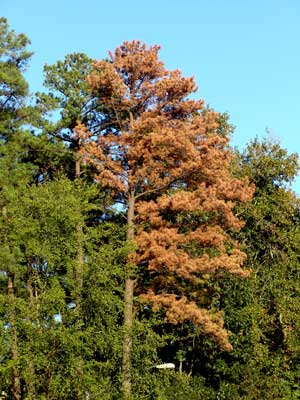
Flora Columnist
Dead pines throughout our community are easy to spot. Isolated single specimens or groups of two or three pines lend a copper-brown color to the green tree canopy.
The deaths of isolated small groups of trees are most likely the result of Ips engraver beetles. There are three species, the small Ips, the medium Ips and the one we most likely have, the large Ips.
Fortunately, the Ips beetle is not a large-scale killer of pines, unlike the southern pine beetle, which is notorious for destroying entire stands of pines.
Longtime residents may recollect the large-scale infestation of southern pine beetles back in the mid 1970s. Loss of valuable timber and removal of stands of pines from residential properties was a great expense to many folks back then.
A fifth pine beetle common in the South is the turpentine beetle, which generally doesn’t kill trees, but certainly makes them more vulnerable to the other beetles.
Life cycles of all the beetles are similar.
The most destructive southern pine beetle is a little one-eighth-inch-long black beetle that usually attacks a tree stressed by drought or other environmental causes and/or construction-caused tree-trunk injury and root compaction. Unlike the smaller populations of other beetles, southern pine beetle populations may be in the thousands.
Beetles bore through the outer bark into the living inner bark, where they deposit eggs. Eggs quickly hatch into ravenous little larvae eating their way throughout the inner bark, cambium, until they pass through a resting, pupa, stage before emerging as the next generation of adults to begin the cycle again, all within as little time as four weeks.
The trees die because movement of water and other nutrients within the inner bark is halted by the girdling effect of the eating chambers of countless larvae. Blue-stain fungus pathogens often accompany the adult beetles boring into the bark, resulting in additional disruption of nutrient transport within the inner bark.
Beetle entries are easily identified by the presence of a “pitch tube,†appearing as a small popcorn-size ball of sap, resin, exuding from the tree. Healthy trees exude sap quickly enough to trap attacking beetles. Stressed trees don’t have that vigor. Attacked trees are generally not detected until their crowns have turned red, by which time much of the next generation of beetles has exited. Exit holes appear as pinhead-sized holes scattered on the outer bark.
The common practice in controlling southern pine beetle infestations is to cut and remove adjoining living green pines within a radius of 40 to70 feet around the dead stand, which also is removed.
Such drastic measures are not required for infestations of Ips engraver beetles. There is no necessity to remove uninfested nearby living trees. If a tree or a few trees killed by Ips beetles do not pose danger of injury or physical damage where they will eventually fall to earth, the dead tree(s) left standing serve as “snag†trees, hosting secondary invading insects and serving as havens of food and nesting sites for woodpeckers and other birds.
If you have a dead pine or suspected beetle-infested tree on your property, contact the N.C. Forest Service’s Hillsborough office (732-8152) and request an assessment of your particular situation. You may save significant expense and make some woodpeckers very happy.
Email Ken Moore at flora@carrborocitizen.com.


